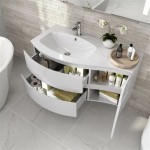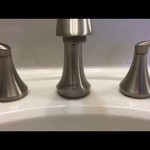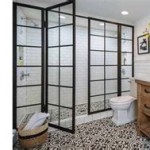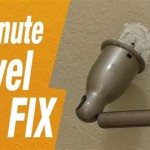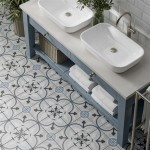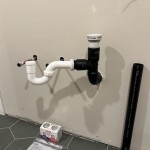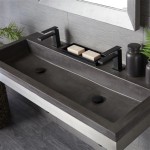How to Damp Proof a Bathroom
Bathrooms are inherently prone to moisture due to their constant exposure to water. This moisture can lead to a range of problems, including mold growth, structural damage, and health issues. Damp-proofing a bathroom is essential to prevent these issues and create a healthy and comfortable environment. This article will guide you through the process of damp-proofing your bathroom, highlighting key steps and considerations.
1. Identify the Source of Moisture
Before embarking on any damp-proofing solutions, it's crucial to identify the source of the moisture. This step is vital for ensuring the effectiveness of your efforts. Common sources of moisture in bathrooms include:
- Leaky Pipes and Plumbing: Faulty or leaking pipes can be a significant source of water ingress, leading to dampness and mold growth.
- Inadequate Ventilation: Poor ventilation allows moisture to linger in the air, creating an ideal breeding ground for mold and mildew.
- Shower and Bath Splashes: Water splashes from showers and baths can accumulate on walls and floors, contributing to dampness.
- Condensation: Warm, moist air from showers and baths can condense on cold surfaces like bathroom walls and windows, leading to dampness.
- Roof Leaks: Leaky roofs can allow rainwater to seep into the bathroom, causing extensive damage.
Once you've identified the source of moisture, you can address it effectively. For instance, if a leaky pipe is the culprit, it needs to be repaired promptly. If inadequate ventilation is the problem, installing an extractor fan or improving existing ventilation can significantly reduce moisture levels.
2. Apply Damp-Proofing Membrane
A damp-proof membrane is a barrier that prevents moisture from penetrating walls and floors. It's typically made of polyethylene or PVC and is applied as a sheet or liquid coating. Applying a damp-proof membrane is a crucial step in damp-proofing a bathroom, especially if the existing structure is prone to moisture ingress.
When applying a damp-proof membrane, it's essential to follow these steps:
- Prepare the Surface: Ensure the surface is clean, dry, and free from any loose debris, paint, or coatings that could impede the membrane's adhesion.
- Apply the Membrane: Apply the membrane according to the manufacturer's instructions, ensuring that it's applied smoothly and evenly to create a continuous barrier.
- Overlap and Seal: Overlap the membrane sheets by at least 100mm and seal the joints using a suitable sealant to prevent moisture from penetrating.
- Allow Drying Time: Allow the membrane to dry completely before proceeding with the next step.
Damp-proof membranes are effective in preventing moisture from entering the building structure, thus protecting your bathroom from the damaging effects of dampness.
3. Improve Ventilation
Adequate ventilation is essential for removing moisture from the bathroom air and preventing condensation. Installing an extractor fan is an effective way to improve ventilation. Ensure the fan is powerful enough to remove moisture efficiently and is connected to an external vent for proper air extraction.
In addition to an extractor fan, consider these measures to improve bathroom ventilation:
- Open Windows After Showers: Open the windows after showers and baths to allow moist air to escape and fresh air to circulate.
- Ensure Adequate Airflow: Ensure that the bathroom is well-ventilated by providing adequate airflow from other rooms through open doors or vents.
- Use a Dehumidifier: If condensation is a significant concern, consider using a dehumidifier to remove excess moisture from the air.
By improving ventilation, you can create a drier environment that discourages mold growth and prevents the damaging effects of moisture.
4. Consider Other Damp-Proofing Measures
In addition to the key steps mentioned above, consider these other damp-proofing measures:
- Use Waterproof Materials: Opt for waterproof materials like ceramic tiles, waterproof grout, and sealed hardwood floors for your bathroom. These materials resist moisture ingress, reducing the risk of dampness.
- Seal Gaps and Cracks: Seal any gaps or cracks in walls, floors, and around plumbing fixtures with a suitable sealant to prevent moisture from penetrating.
- Regular Inspection: Regularly inspect your bathroom for signs of dampness, such as mold growth, peeling paint, or a musty smell. Addressing these issues early can prevent further damage.
Implementing these additional measures can further enhance the damp-proofing of your bathroom, creating a healthier and more durable space.

How To Stop Damp In Bathroom Expert Guide From Timberwise

How To Treat Damp Walls Before Painting Living By Homeserve

Damp Proof Paint Bathrooms Basement Cures And Prevents Dampness

Damp Proofing Old Bathroom By K L Property Services Refurbishment And Renovation

How To Stop Damp In Bathroom Expert Guide From Timberwise

How To Do Damp Proof Membrane F Ball F77 Dpm On Concrete Floor Water Liquid

What Is A Damp Proof Membrane And How Does It Work Timberwise

How To Cure Damp And Mould In The Bathroom

Dealing With Damp In Bathrooms

What Is A Damp Proof Injection How Does It Work
Related Posts
